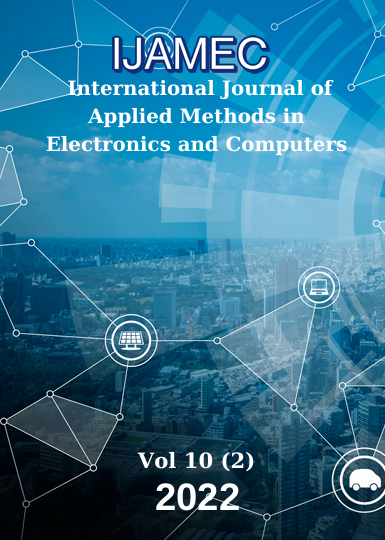Selçuk weather station and web-mobile applications
DOI:
https://doi.org/10.18100/ijamec.1058129Keywords:
Meteorology, Weather tracking, Sensor data, Hybrid mobile developmentAbstract
In this paper, a system for reading meteorological data like temperature, humidity, air pressure, wind speed, wind direction, and rainfall at regular intervals, deployed in Selçuk University Alaeddin Keykubat Campus. The system also provides real-time images and video time-lapses of the campus sky. These data are made available to university people via a website and mobile applications for both iOS and Android. The website and mobile applications provide a clear experience for the users, also explaining the icons and terms used on the website. Users can access the system archive in graphical ways.Downloads
References
Denissen, J.J.A., et al., The effects of weather on daily mood: A multilevel approach. Emotion, 2008. 8(5): p. 662-667.
Trenberth, K.E., et al., Effects of changing climate on weather and human activities. 2000, University Science Books Sausalito, CA.
Colston, J.M., et al., Evaluating meteorological data from weather stations, and from satellites and global models for a multi-site epidemiological study. Environmental research, 2018. 165: p. 91-109.
McGregor, G.R., et al., Heatwaves and health: guidance on warning-system development. 2015: WMOP.
Keggenhoff, I., M. Elizbarashvili, and L. King, Heat wave events over Georgia since 1961: climatology, changes and severity. Climate, 2015. 3(2): p. 308-328.
Pachauri, R.K., et al., Climate change 2014: synthesis report. Contribution of Working Groups I, II and III to the fifth assessment report of the Intergovernmental Panel on Climate Change. 2014: Ipcc.
DURSUN, Ö.O., Meteorolojik verilerin akıllı yöntemlerle sınıflandırılması/The classification of the meteorological data using the intelligent methods. 2005.
Ünal Çalargün, S., Fuzzy association rule mining from spatio-temporal data: an analysis of meteorological data in turkey. 2008, Middle East Technical University.
Smith, T.M. and V. Lakshmanan, Real-time, rapidly updating severe weather products for virtual globes. Computers & Geosciences, 2011. 37(1): p. 3-12.
Williams, M., et al., Automatic processing, quality assurance and serving of real-time weather data. Computers & Geosciences, 2011. 37(3): p. 353-362.
TURAL, S.Y. and R.T.D. SAMET, Gerçek zamanlı meteoroloji verilerinin toplanması, analizi ve haritalanması. 2011, Ankara Üniversitesi Fen Bilimleri Enstitüsü Bilgisayar Mühendisliği Anabilim
Altan, N.T., Dalgacık Dönüşümü Kullanılarak Zirai-meteorolojik Verilerin Hata Teşhis Ve Tamiri. 2012, Bilişim Enstitüsü.
Gökrem, L., M. Durgun, and Y. Durgun, İnternet Tabanlı Meteorolojik Ölçüm Cihazının Geliştirilmesi ve Performansının Belirlenmesi.
Arroyo, Á., et al., Analysis of meteorological conditions in Spain by means of clustering techniques. Journal of Applied Logic, 2017. 24: p. 76-89.
Chu, W.-T., X.-Y. Zheng, and D.-S. Ding, Camera as weather sensor: Estimating weather information from single images. Journal of Visual Communication and Image Representation, 2017. 46: p. 233-249.
Number of available applications in the Google Play Store from December 2009 to July 2021 2021; Available from: https://www.statista.com/statistics/266210/number-of-available-applications-in-the-google-play-store/.
Li, T., et al., ”What Apps Did You Use?”: Understanding the Long-term Evolution of Mobile App Usage, in Proceedings of The Web Conference 2020. 2020, Association for Computing Machinery: Taipei, Taiwan. p. 66–76.
Kuśmierek-Tomaszewska, R., J. Żarski, and S. Dudek, Meteorological automated weather station data application for plant water requirements estimation. Computers and Electronics in Agriculture, 2012. 88: p. 44-51.
Abbate, S., et al., Deploying a communicating automatic weather station on an Alpine Glacier. Procedia computer science, 2013. 19: p. 1190-1195.
Sultan, A.-Y., et al., Assessment of wind energy potential locations in Oman using data from existing weather stations. Renewable and Sustainable Energy Reviews, 2010. 14(5): p. 1428-1436.
Bomhold, C.R., Educational use of smart phone technology: A survey of mobile phone application use by undergraduate university students. Program, 2013.
Zabini, F., Mobile weather apps or the illusion of certainty. Meteorological Applications, 2016. 23(4): p. 663-670.
Popelka, S., A. Vondrakova, and P. Hujnakova, Eye-tracking evaluation of weather web maps. ISPRS International Journal of Geo-Information, 2019. 8(6): p. 256.
ExpressJS. 2021; Available from: https://expressjs.com/.
React JS. 2021; Available from: https://reactjs.org/.
Khandeparkar, A., R. Gupta, and B. Sindhya, An introduction to hybrid platform mobile application development. International Journal of Computer Applications, 2015. 118(15).
Wasserman, A.I. Software engineering issues for mobile application development. in Proceedings of the FSE/SDP workshop on Future of software engineering research. 2010.
Waranashiwar, J. and M. Ukey, Ionic Framework with Angular for Hybrid App Development. International Journal of New Technology and Research, 2018. 4(5): p. 263068.
Downloads
Published
Issue
Section
License
Copyright (c) 2022 International Journal of Applied Methods in Electronics and Computers

This work is licensed under a Creative Commons Attribution-ShareAlike 4.0 International License.





